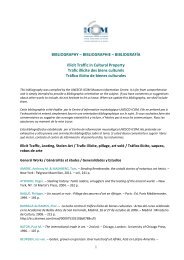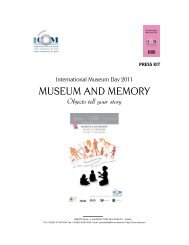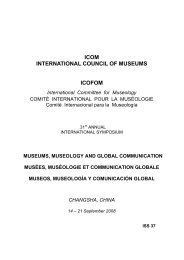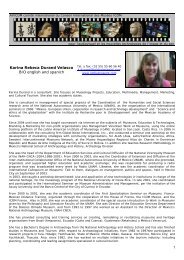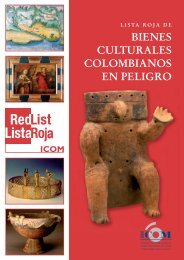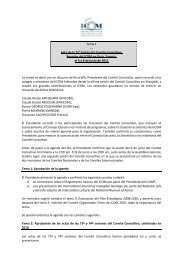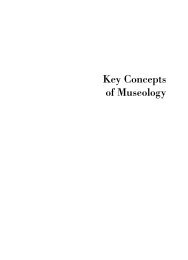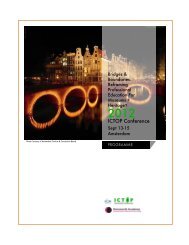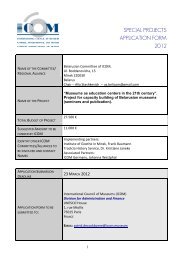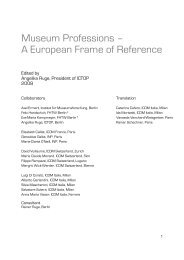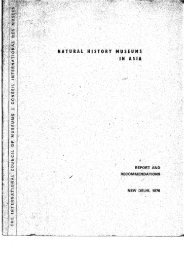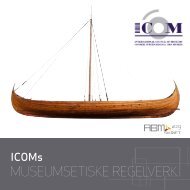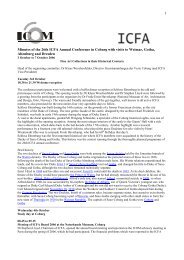ISS 25 (1995).pdf - The International Council of Museums
ISS 25 (1995).pdf - The International Council of Museums
ISS 25 (1995).pdf - The International Council of Museums
You also want an ePaper? Increase the reach of your titles
YUMPU automatically turns print PDFs into web optimized ePapers that Google loves.
<strong>The</strong> Finances<br />
<strong>The</strong> flow <strong>of</strong> money is a detenninant in most human endeavour and is cenainly a major<br />
parameter in shaping the purpose and structure <strong>of</strong> museums. Most museums are dependent<br />
upon tax dollars and as such these institutions feel obligated to serve the broadest tax pacing<br />
public that is possible. With nations that have a strong cultural identity, this identity would be<br />
fostered by a national museum giving purpose to the existence <strong>of</strong> a national type and that form<br />
<strong>of</strong> visual and tangible history that museum collections <strong>of</strong>fer. Where nations have old defined<br />
national cultural attributes, the expenditure <strong>of</strong> tax dollars can be easily justified in promoting<br />
those national cultures through heritage collections. It is the case, however, that special<br />
interest groups assemble their own private money and spend it promoting the materials which<br />
give meaning to their causes. In the same vein, private collectors who have amassed dollars and<br />
collections which reflect their personal tastes have opened museums to exhibit their treasures<br />
and these have obvious credentials for their existence. <strong>The</strong> flow <strong>of</strong> money is a strong<br />
determinant in the organization and life <strong>of</strong> museums and with the pressures to sustain a variety<br />
<strong>of</strong> collection perspectives, to serve a variety <strong>of</strong> publics, and to acquire funds which have<br />
realized an increase in demand, it is not surprising that many museums are looking towards<br />
user-defined operations. A user-defined institution sets its objectives as a common goal for a<br />
known public and is supported by the public through donations and admissions. It therefore<br />
gratifies the user-public with information and meaning with the objective <strong>of</strong> ensuring its<br />
financial stability.<br />
Responsive to community needs<br />
It is a relatively new phenomenon where museums undertake to test the public's wants and<br />
needs with surveys and market analysis to discover what an institution's relation with its<br />
community is and/or should be. This phenomenon, most probably, is an <strong>of</strong>fshoot <strong>of</strong> institution's<br />
desires to become financially independent and to set their foundations on a user-defined basis.<br />
Many museums are spending money and time to conduct studies to gauge public reactions,<br />
sentiment and desire, to chart future courses under the heading <strong>of</strong> being responsive to<br />
community needs. In fact, businesses have sprung up in response to this need to locate and<br />
secure a permanent financial footing and to be perceived as being community-responsive, thus<br />
creating a class <strong>of</strong> museum consultants whose expertise is sought after on these pr<strong>of</strong>essional<br />
matters ..<br />
Charging and Value<br />
<strong>Museums</strong> are responding to a heightened social notion that value is equated with cost and that<br />
therefore if you pay little for an item or for admission or for the use <strong>of</strong> a service, then it could<br />
have little value. Hence, those items which have the greatest cost have the greatest value and<br />
museums are increasingly becoming caught up in this entrepreneurial spiral and are charging<br />
70



